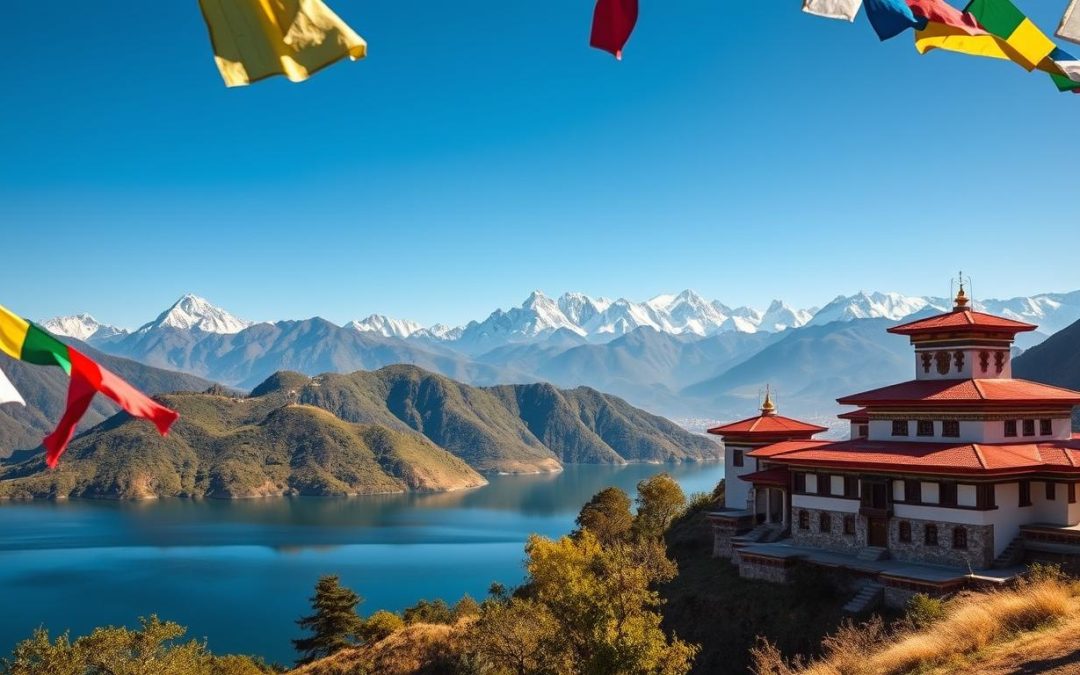Have you ever wondered when the perfect time is to explore a country that blends breathtaking landscapes with vibrant cultural traditions? Bhutan, nestled in the Himalayas, offers a unique experience that changes with the seasons. Its diverse climate, shaped by altitude and monsoons, makes planning your visit an exciting adventure.
From the crisp, clear days of fall to the frosty winters, each season brings its own charm. Fall, after the monsoon, is particularly inviting with pleasant temperatures and stunning views. Winter, though colder, offers clear skies and fewer crowds, making it ideal for those who prefer a quieter journey.
Whether you’re drawn to the colorful festivals or the serene valleys, understanding the weather patterns can help you make the most of your trip. Let’s dive into the best times to visit this enchanting country.
Key Takeaways
- Bhutan’s climate varies with altitude and monsoon influences.
- Fall (late September to November) offers clear skies and mild weather.
- Winter brings fewer tourists and crisp, sunny days.
- Festivals like Tshechu add cultural richness to your visit.
- Plan your trip around quieter periods for a more relaxed experience.
A Closer Look at Bhutan’s Diverse Climate
Understanding the climate of a region can make or break your travel experience. In this Himalayan nation, the weather shifts dramatically with the seasons, offering something unique for every traveler. From lush valleys to snow-capped peaks, the climate here is as diverse as its landscapes.
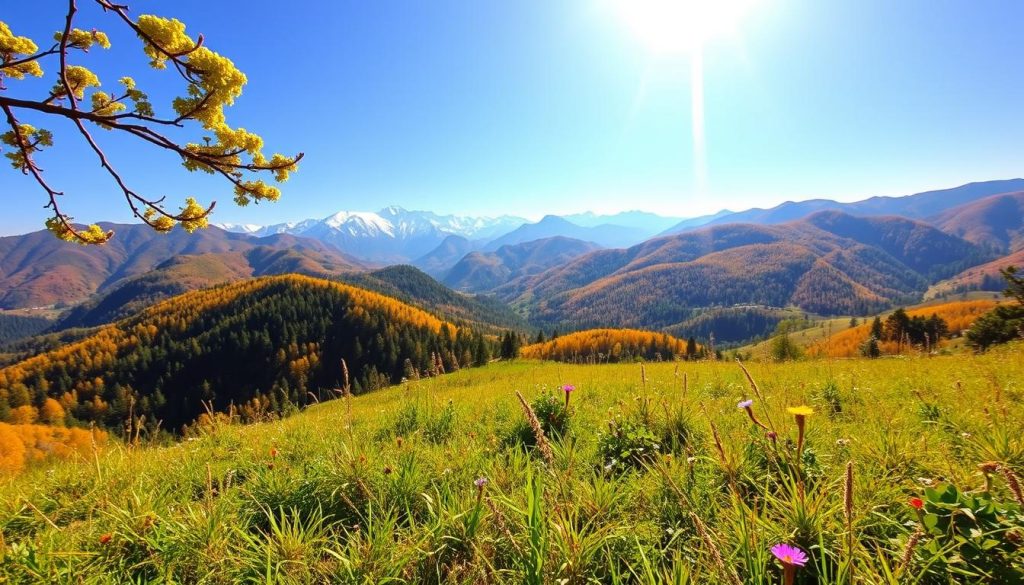
Monsoon and Post-Monsoon Periods
From late June through September, the southwest monsoon brings heavy rains and high humidity. This period can make travel challenging, especially in remote areas. However, the post-monsoon season, from late September to November, is a different story. Bright, sunny days and even early snowfall at high elevations make this an ideal time for exploration.
Locations like Paro and Thimphu experience clearer skies and milder temperatures during this time. If you’re planning a trip, this season offers a perfect balance of pleasant weather and fewer crowds.
Winter Chill and Mountain Snowfall
Winter, from November through March, brings a different kind of beauty. Gale-force winds sweep through high passes, and frost blankets many areas. In cities like Paro and Thimphu, temperatures can drop below zero, creating a crisp, serene atmosphere.
High-altitude regions, such as Bumthang, often see snowfall, making it a winter wonderland. While the cold can be intense, the clear skies and stunning views make it worth braving the chill. Pro tip: Pack warm layers and plan your routes carefully to navigate the icy conditions safely.
Understanding these climatic patterns helps you choose the best time visit for your journey. Whether you’re drawn to the sunny days of post-monsoon or the snowy landscapes of winter, planning around the weather ensures a memorable trip.
Spring and Fall: Peak Seasons for Festivals and Adventure
Spring and fall are the ideal seasons to immerse yourself in both culture and adventure. These months bring pleasant weather, vibrant festivals, and opportunities for outdoor exploration. Whether you’re drawn to cultural events or thrilling treks, these seasons have something for every traveler.
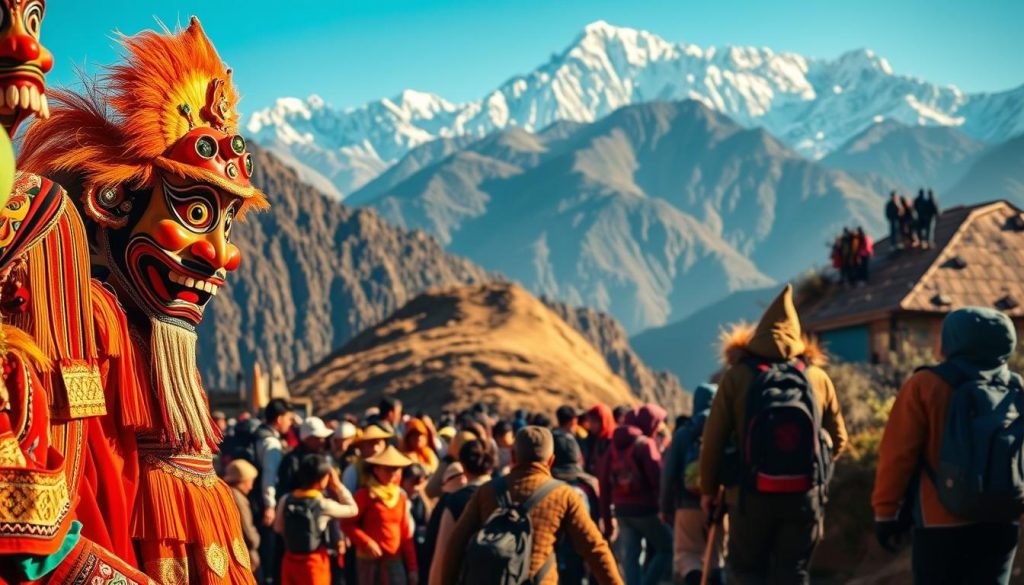
Experience Tshechu Festivals and Cultural Events
One of the highlights of visiting Bhutan during spring and fall is the chance to witness Tshechu festivals. These events are deeply rooted in religious traditions and feature colorful mask dances, music, and cultural exhibitions. Paro Tshechu in April and Thimphu Tshechu in September-October are among the most popular, drawing crowds from across the country.
These festivals are not just about entertainment; they offer a unique glimpse into the spiritual and cultural fabric of the place. Smaller local celebrations also take place, providing a more intimate experience. Attending a Tshechu festival is a must for any visitor seeking to connect with the heart of this destination.
Trekking and Outdoor Explorations
Spring and fall are also the best times for trekking and outdoor adventures. The weather is mild, with clear skies and blooming rhododendrons in late spring. Popular trekking routes, such as those in the Punakha Valley, offer stunning views and a chance to explore the country’s natural beauty.
For those who prefer less strenuous activities, scenic hikes and cultural tours are equally rewarding. The combination of pleasant weather and breathtaking scenery makes these seasons ideal for outdoor enthusiasts. Whether you’re an experienced trekker or a casual traveler, spring and fall provide the perfect conditions for exploration.
By planning your trip during these peak seasons, you can enjoy a balanced experience of cultural immersion and adventure. From vibrant festivals to serene landscapes, these months offer the best of both worlds.
Bhutan: Best Months for a Weather-Savvy Trip
Each month in this Himalayan destination offers unique weather and activities. Whether you’re drawn to vibrant festivals or serene landscapes, understanding the monthly climate can help you plan the perfect journey.
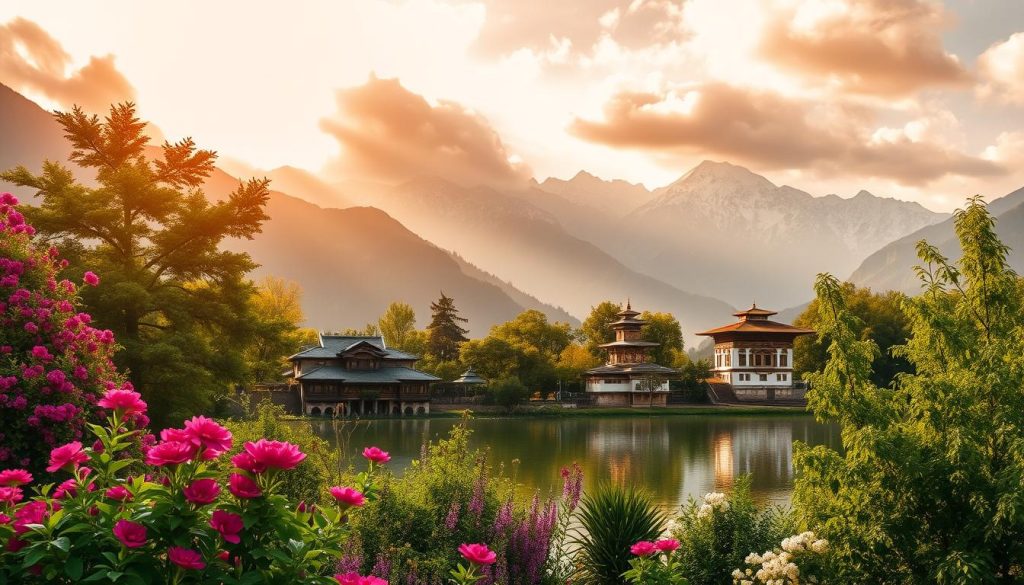
Month-by-Month Highlights for Your Journey
March to May: Spring is a magical time to visit. Temperatures range from 15°C to 25°C, making it ideal for outdoor adventures. The valleys come alive with blooming rhododendrons, and festivals like Paro Tshechu add cultural richness to your trip.
June to August: Monsoon season brings heavy rains, especially in the south. While travel can be challenging, the lush greenery and fewer crowds make it a unique experience. High-altitude areas like Bumthang remain drier and cooler.
September to November: Fall is one of the best times to explore. Clear skies, mild weather, and events like Thimphu Tshechu create a perfect blend of culture and nature. Trekking conditions are excellent, with stunning views of the Himalayas.
December to February: Winter transforms the region into a snowy wonderland. While temperatures can drop below zero, the crisp air and clear skies offer breathtaking views. High-altitude areas like Punakha see snowfall, adding to the charm.
By aligning your trip with the right month, you can enjoy the best of this destination’s weather and events. Whether you’re trekking through blooming valleys or attending colorful festivals, strategic planning ensures a memorable adventure.
Navigating the Crowds: High vs. Low Tourist Seasons
Planning your trip around the crowds can make all the difference in your travel experience. Understanding the dynamics of high and low tourist seasons helps you tailor your journey to your preferences, whether you seek vibrant festivals or serene landscapes.
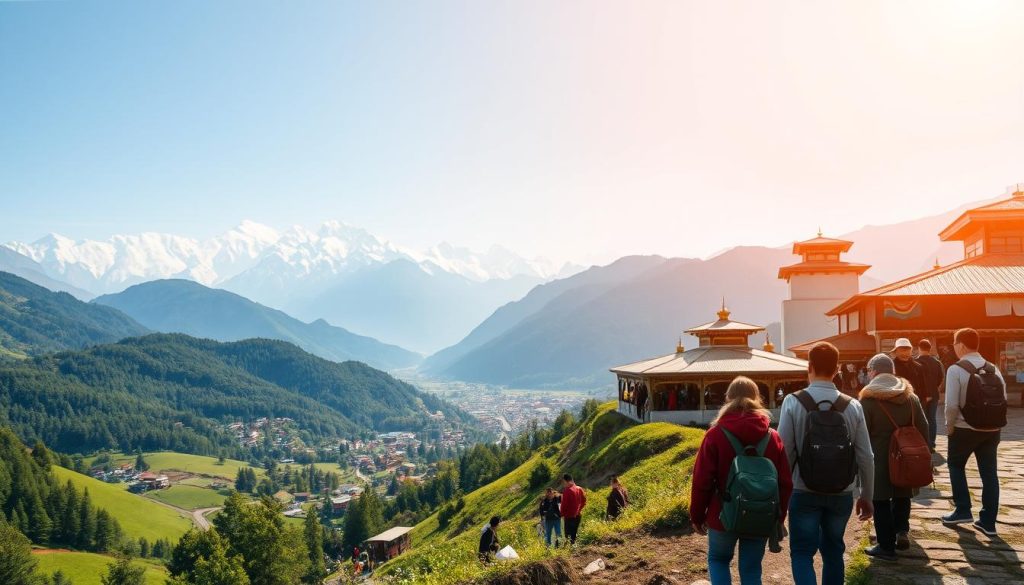
Understanding Peak Season Rates and Events
The high season in this destination falls in spring (March to May) and fall (September to November). During these months, you’ll find bustling festivals like the Thimphu Tshechu, where colorful mask dances and cultural exhibitions take center stage. However, this popularity comes with higher hotel rates and larger crowds.
If you’re drawn to lively events and don’t mind the buzz, this is the perfect time to visit. Pro tip: Book accommodations and tours well in advance to secure the best options and avoid last-minute price hikes.
Tips for Enjoying Quieter Periods
For a more relaxed experience, consider traveling during the low season (December to February and June to August). These months offer fewer visitors and lower prices, making it easier to explore at your own pace. Winter brings crisp, sunny days, while summer’s lush greenery creates a tranquil atmosphere.
Quieter periods are ideal for activities like birdwatching or exploring mountain passes without the crowds. Insider tip: Pack appropriately for the weather, as winter can be chilly and summer may bring occasional rain.
By choosing the right season for your trip, you can enjoy a personalized experience that matches your travel style. Whether you prefer the energy of festivals or the peace of quieter days, understanding crowd dynamics ensures a memorable journey.
Unique Regional Insights: Valleys, Mountains, and Wildlife
Exploring the diverse regions of this Himalayan country reveals a world of unique valleys, towering mountains, and vibrant wildlife. Each area offers distinct cultural atmospheres and natural scenery, making it a treasure trove for travelers. From the lush Phobjikha Valley to the remote mountain passes, there’s something for everyone.
Spotting the Rare Black-Necked Crane
One of the most iconic sights in the Phobjikha Valley is the rare black-necked crane. These majestic birds migrate here during the winter months, offering a breathtaking view for nature enthusiasts. February is the best time to witness this event, as the valley transforms into a serene habitat for these endangered species.
To make the most of your visit, plan your trip around early mornings or late afternoons when the cranes are most active. Local guides can provide valuable insights into their behavior and conservation efforts. This experience is a must for anyone passionate about wildlife and conservation.
Cultural Immersion in Local Festivals
Beyond the well-known Tshechu festivals, smaller community events offer an authentic glimpse into local traditions. These gatherings, often held in remote valleys, showcase traditional music, dance, and crafts. Visiting during these events allows you to connect deeply with the culture.
For example, the Gangtey Tshechu in October is a lesser-known but equally vibrant celebration. It’s held in the Gangtey Monastery and features masked dances and religious rituals. Such events provide a unique opportunity to experience the country’s spiritual heritage away from the crowds.
| Region | Highlight | Best Time to Visit |
|---|---|---|
| Phobjikha Valley | Black-necked crane sightings | February |
| Punakha Valley | Punakha Dzong and lush scenery | April |
| Bumthang | Local festivals and mountain views | October |
By exploring these regional gems, you’ll gain a deeper appreciation for the country’s cultural diversity and natural beauty. Whether you’re spotting rare wildlife or attending a local festival, each experience adds a unique layer to your journey.
Detailed Month-by-Month Weather and Temperature Guide
To make the most of your journey, understanding the monthly weather patterns is essential. The climate here varies dramatically with altitude and season, offering unique experiences every month. From crisp winters to lush monsoons, each period has its own charm.
Weather Patterns and Temperature Ranges
In regions like Paro and Bumthang, temperatures can drop below zero during winter nights. December to February brings frosty mornings and clear skies, perfect for scenic views. High-altitude areas like Jakar often see early snowfall, adding to the winter wonderland vibe.
Spring, from March to May, is mild and pleasant. Daytime temperatures range from 15°C to 25°C, making it ideal for outdoor activities. The valleys come alive with blooming rhododendrons, creating a picturesque backdrop.
Monsoon season, from June to August, brings heavy rains, especially in the south. While travel can be challenging, the lush greenery and fewer crowds make it a unique experience. High-altitude areas remain drier and cooler.
Fall, from September to November, is one of the best times to explore. Clear skies and mild weather create perfect conditions for trekking and cultural events. The post-monsoon period offers stunning views of the Himalayas.
Preparing for Variable Conditions
Packing appropriately is key to enjoying your trip. Winter requires warm layers, including thermal wear and insulated jackets. Spring and fall call for light clothing, but always carry a jacket for cooler evenings.
During the monsoon, waterproof gear is essential. Sturdy footwear is a must for navigating slippery trails. High-altitude treks demand proper acclimatization and gear to handle sudden weather changes.
By aligning your trip with the right month, you can enjoy the best of this destination’s weather and events. Whether you’re trekking through blooming valleys or attending colorful festivals, strategic planning ensures a memorable adventure.
Conclusion
Planning your journey with both weather and cultural events in mind ensures a truly unforgettable experience. From the crisp, sunny days of winter to the vibrant festivals in Thimphu, each season offers something unique. Understanding the time of year that suits your interests can make all the difference.
Whether you’re exploring the serene valleys or attending lively events, aligning your tour with the right season enhances your adventure. Use the detailed month-by-month guide to tailor your itinerary and make the most of your travel.
With its breathtaking scenery and rich cultural heritage, this country promises an experience like no other. Start planning today and get ready to immerse yourself in its beauty and traditions. Your unforgettable journey awaits!
The above is subject to change.
Check back often to TRAVEL.COM for the latest travel tips and deals.
Here are some Tours & Sightseeing suggestions that might pique your interests!
